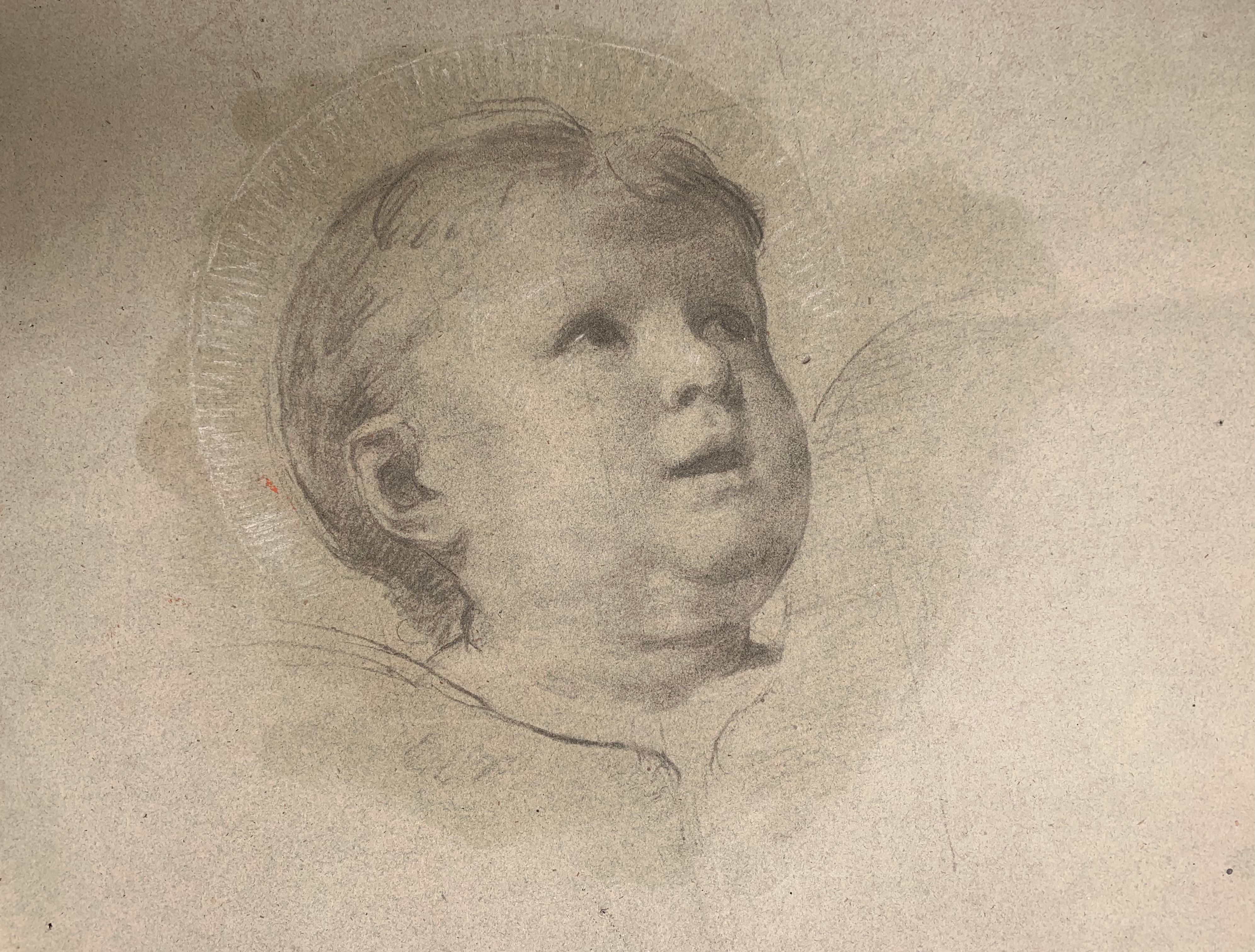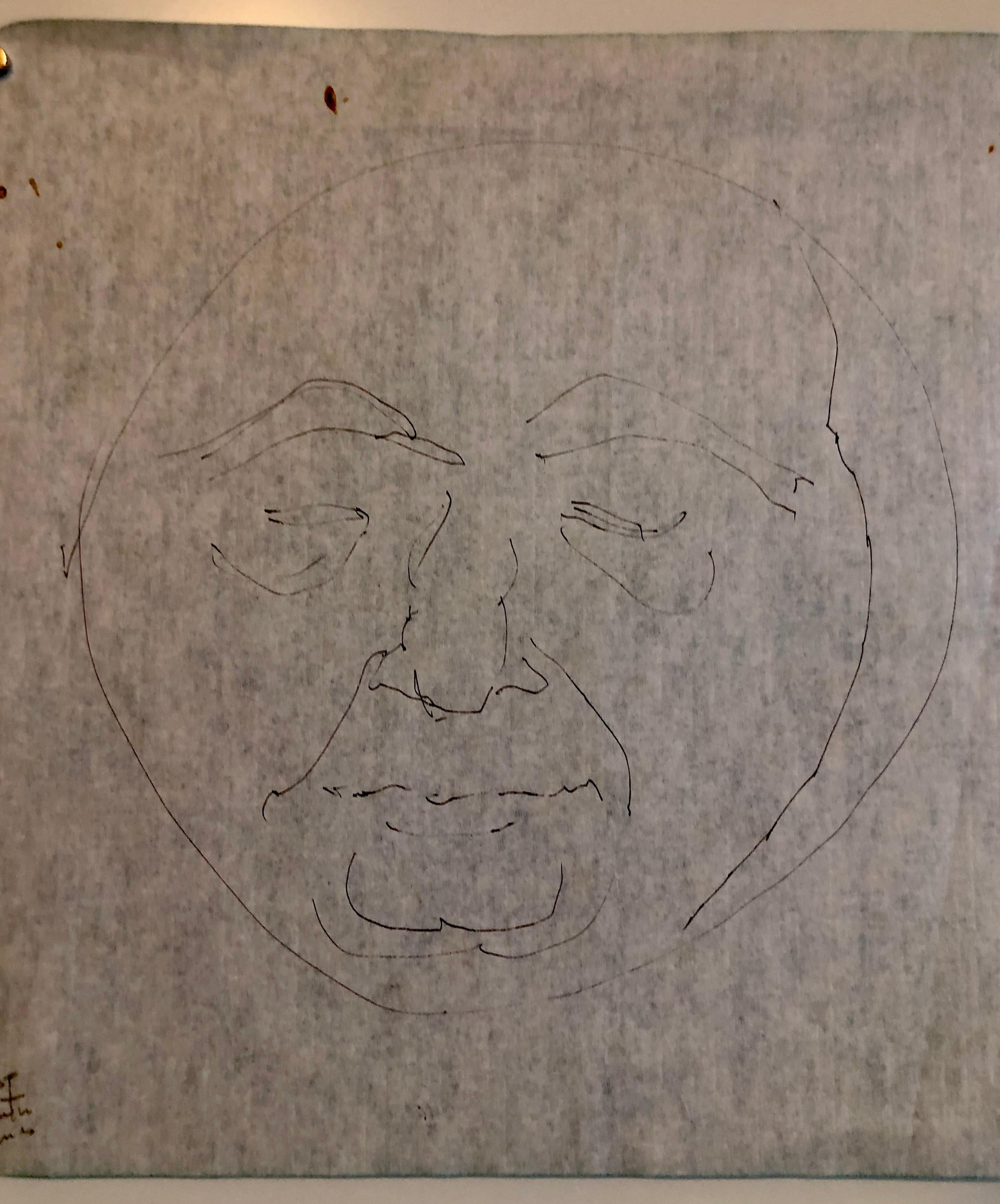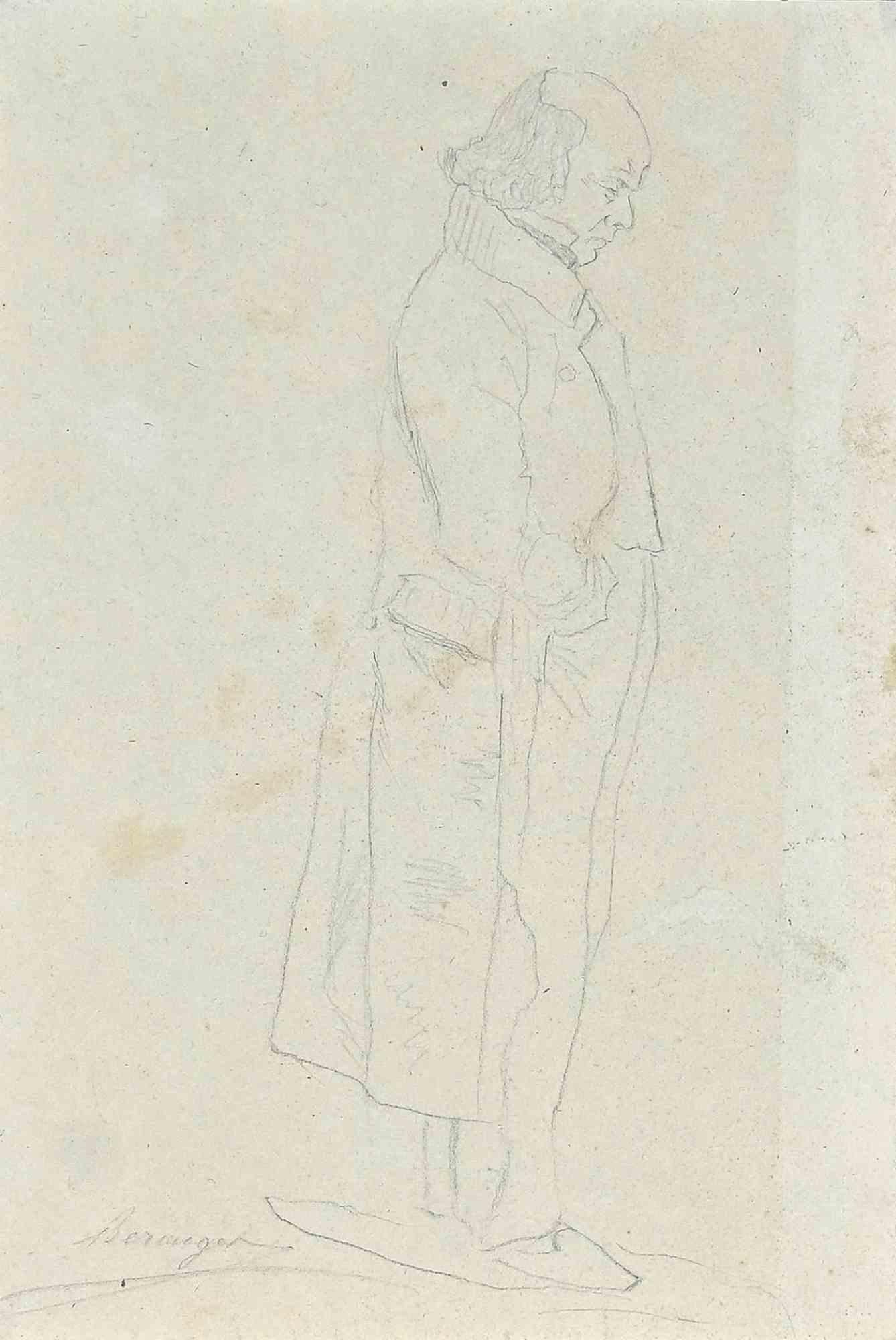Items Similar to The Girl - Pencil on Paper by Michel Dumas - 1850s
Want more images or videos?
Request additional images or videos from the seller
1 of 3
Michel DumasThe Girl - Pencil on Paper by Michel Dumas - 1850s1850s
1850s
About the Item
The Girl is an interesting preparatory sketch in pencil realized by the French artist Michel Dumas in the mid-19th century.
The state of preservation is good, except for some stains and foldings.
stamped by the name of Artist on the rear.
Sheet dimension: 20 x 31 cm.
The artwork represents the sketch of a girl skillfully practiced through soft strokes.
Michel Dumas was a French painter from Lyons. He was a pupil of Grobon and Bonnefond at the School of Fine Arts in Lyons. He moved to Paris, where he entered the workshop of Ingres, with whom he established a lifelong friendship. Thanks to the income from private commissions, he left for Rome, where he has stayed, with Ingres, for 16 years. He ended his career in his hometown as professor at the École des Beaux-Arts in Lyons and died in 1878.
- Creator:Michel Dumas (1812 - 1885)
- Creation Year:1850s
- Dimensions:Height: 7.88 in (20 cm)Width: 12.21 in (31 cm)Depth: 0.04 in (1 mm)
- Medium:
- Period:
- Framing:Framing Options Available
- Condition:Insurance may be requested by customers as additional service, contact us for more information.
- Gallery Location:Roma, IT
- Reference Number:
About the Seller
4.9
Platinum Seller
These expertly vetted sellers are 1stDibs' most experienced sellers and are rated highest by our customers.
1stDibs seller since 2017
6,753 sales on 1stDibs
Typical response time: 2 hours
- ShippingRetrieving quote...Ships From: Grasse, France
- Return PolicyA return for this item may be initiated within 14 days of delivery.
More From This SellerView All
- Nude of Woman - Original Drawing by Alexandre Bida - Mid 19th CenturyLocated in Roma, ITNude of Woman is an Original pencil and white lead Drawing realized by Alexandre Bida (1823-1895). The artwork in good condition on a clue paper, inclu...Category
Mid-19th Century Modern Figurative Drawings and Watercolors
MaterialsPencil
- Portrait of Pierre-Jean de Béranger - Original Drawing - Early 19th CenturyLocated in Roma, ITPortrait of Pierre-Jean de Béranger is an original drawing in Pencil realized in the Early 19th Century. Good conditions. The artwork is depicted through soft strokes in a well-bal...Category
Early 20th Century Modern Figurative Drawings and Watercolors
MaterialsPencil
- The Figures Sketches - Drawing by Norbert Meyre - Mid-20th CenturyLocated in Roma, ITThe Figures Sketches is an original Drawing on paper realized by French painter Norbert Meyre in the mid-20 century. Drawing in pencil and pen. The ...Category
Mid-20th Century Modern Figurative Drawings and Watercolors
MaterialsPen, Pencil
- The Kiss - Original Pencil Drawing by Alfred Grevin - Late 19th CenturyBy Alfred GrevinLocated in Roma, ITThe Kiss is an original drawing in Pencil realized by Alfred Grévin in the Late-19 Century. Applied on a Passeprtout: 50 x 32 cm. In good conditions. Alfred Grévin (1827- 1892),w...Category
Late 19th Century Modern Figurative Drawings and Watercolors
MaterialsPencil
- Men In The Outdoor - Original Drawing by Alfred Grevin - Late 19th CenturyBy Alfred GrevinLocated in Roma, ITMen In The Outdoor is an original drawing in Pencil realized by Alfred Grévin in the Late-19 Century. Applied on a Passepartout: 50 x 33 cm. In good conditions. Alfred Grévin (18...Category
Late 19th Century Modern Figurative Drawings and Watercolors
MaterialsPencil
- The Motherhood - Drawing by Mino Maccari - Mid-20th CenturyBy Mino MaccariLocated in Roma, ITThe Motherhood is an Original Drawing in pencil carbon on creamy-colored paper realized by Mino Maccari in the mid-20th century. Hand-signed by the artist on the lower. Good condi...Category
Mid-20th Century Modern Figurative Drawings and Watercolors
MaterialsCarbon Pencil
You May Also Like
- Bozzetto Accademico della Testa di un Cherubino.Located in Firenze, ITBozzetto Accademico della Testa di un Cherubino. Disegno a carboncino e gessetto bianco su carta leggermente colorata di grigio. Seconda metà dell'Ottocento In buone condizioni. Prov...Category
19th Century Academic Figurative Drawings and Watercolors
MaterialsPaper, Chalk, Pencil
- Moses Breaking the Tablet of the Law (after Parmigianino. 1503-1540)By Daniel RaméeLocated in Storrs, CTMoses Breaking the Tablet of the Law. (after Parmigianino. 1503-1540.) Pencil drawing mounted onto paper. 12 1/4 x 3 3/4 inches. Collector's seal verso: Gustav Grunwald, (Lugt 1155b)...Category
19th Century Old Masters Portrait Drawings and Watercolors
MaterialsPencil
- Old Jewish Shtetl Rabbi Charcoal Judaica Drawing World War II EraBy Maurycy TrebaczLocated in Surfside, FLMaurycy Trębacz (1861 – 1941) was one of the most popular Jewish painters in Poland in the late 19th and early 20th century. Many of his paintings were lost in the Holocaust, but a r...Category
1930s Expressionist Figurative Drawings and Watercolors
MaterialsPaper, Charcoal, Graphite
- Boston Abstract Expressionist Hyman Bloom Original Pencil Drawing Martin SumersBy Hyman BloomLocated in Surfside, FLThis is a unique artwork. This is an original Hyman Bloom drawing of fellow artist and his very good friend Martin Sumers.I believe this was drawn at the “variations of a theme” at Sumers gallery in NYC. The last two photos show a poster and a card from their shows. it is not included in this listing, it is just for provenance. Provenance: Acquired from the Sumers estate collection. Hyman Bloom (March 29, 1913 – August 26, 2009) was a Latvian-born American painter. His work was influenced by his Jewish heritage and Eastern religions as well as by artists including Altdorfer, Grünewald, Caravaggio, Rembrandt, Blake, Bresdin, James Ensor and Chaim Soutine. He first came to prominence when his work was included in the 1942 Museum of Modern Art exhibition "Americans 1942 -- 18 Artists from 9 States". MoMA purchased 2 paintings from the exhibition and Time magazine singled him out as a "striking discovery" in their exhibition review. His work was selected for both the 1948 and 1950 Venice Biennale exhibitions and his 1954 retrospective traveled from Boston's Institute of Contemporary Art to the Albright Gallery and the de Young Museum before closing out at The Whitney Museum of American Art in 1955. In a 1954 interview with Yale art professor Bernard Chaet, Willem de Kooning indicated that he and Jackson Pollock both considered Bloom to be “America’s first abstract expressionist”, a label that Bloom would disavow. Starting in the mid 1950s his work began to shift more towards works on paper and he exclusively focused on drawing throughout the 1960s, returning to painting in 1971. He continued both drawing and painting until his death in 2009 at the age of 9 Hyman Bloom (né Melamed) was born into an orthodox Jewish family in the tiny Jewish village of Brunavišķi in what is now Latvia, then part of the Russian Empire At a young age Bloom planned to become a rabbi, but his family could not find a suitable teacher. In the eighth grade he received a scholarship to a program for gifted high school students at the Museum of Fine Arts. He attended the Boston High School of Commerce, which was near the museum. He also took art classes at the West End Community Center, a settlement house. The classes were taught by Harold Zimmerman, a student at the School of the Museum of Fine Arts, who also taught the young Jack Levine at another settlement house in Roxbury. When Bloom was fifteen, he and Levine began studying with a well-known Harvard art professor, Denman Ross, who rented a studio for the purpose and paid the boys a weekly stipend to enable them to continue their studies rather than take jobs to support their families. He took Bloom and Levine on a field trip to the Museum of Modern Art in New York, where Bloom was impressed by the work of Rouault and Soutine and began experimenting with their expressive painting styles. In the 1930s Bloom worked sporadically for the Public Works of Art Project and the Federal Art Project (WPA), He shared a studio in the South End with Levine and another artist, Betty Chase. It was during this period that he developed a lifelong interest in Eastern philosophy and music, and in Theosophy. He first received national attention in 1942 when thirteen of his paintings were included in the Museum of Modern Art (MoMA) exhibition Americans 1942: 18 Artists from 9 States, curated by Dorothy Miller. MoMA purchased two of his paintings from that exhibition, and he was featured in Time magazine. The titles of his paintings in the exhibition reflect some of his recurring themes. Two were titled The Synagogue, another, Jew with the Torah; Bloom was actually criticized by one reviewer for including "stereotypical" Jewish images. He also had two paintings titled The Christmas Tree, and another titled The Chandelier, both subjects he returned to repeatedly. Another, Skeleton (c. 1936), was followed by a series of cadaver paintings in the forties, and The Fish (c. 1936) was one of many paintings and drawings of fish he created over the course of his career. Bloom was associated at first with the growing Abstract Expressionist movement. Willem de Kooning and Jackson Pollock, who first saw Bloom's work at the MoMA exhibition, considered Bloom "the first Abstract Expressionist artist in America." In 1950 he was chosen, along with the likes of de Kooning, Pollock, and Arshile Gorky, to represent the United States at the Venice Biennale. That same year Elaine de Kooning wrote about Bloom in ARTnews, noting that in paintings such as The Harpies, his work approached total abstraction: "the whole impact is carried in the boiling action of the pigment". In 1951 Thomas B. Hess reproduced Bloom's Archaeological Treasure in his first book, Abstract Painting: Background and American Phase, along with works by Picasso, Pollock, and others. Both de Kooning and Hess remarked on Bloom's expressive paint handling, a key characteristic of Abstract Expressionist painting. As abstract expressionism dominated the American art world, Bloom became disenchanted with it, calling it "emotional catharsis, with no intellectual basis." In addition, instead of moving to New York to pursue his career, he opted to stay in Boston. As a result he fell out of favor with critics and never achieved the kind of fame that Pollock and others did. He disliked self-promotion and never placed much value on critical acclaim. Many of Bloom's paintings feature rabbis, usually holding the Torah. According to Bloom, his intentions were more artistic than religious. He began questioning his Jewish faith early in life, and painted rabbis, he claimed, because that was what he knew. Over the course of his career he produced dozens of paintings of rabbis...Category
20th Century Modern Figurative Drawings and Watercolors
MaterialsPaper, Pencil
- Portrait of a Young Girl WritingBy Guillaume DulacLocated in London, GB'Portrait of a Young Girl Writing', pencil on art paper, by French artist, Guillaume Dulac (circa 1920s). An artist known for his exquisite drawings - man...Category
1920s Portrait Drawings and Watercolors
MaterialsPaper, Pencil
- Jairo- Portrait. Watercolor and ink on archival paper drawingBy Celso José Castro DazaLocated in Miami Beach, FLJairo, 2016 by Celso Castro-Daza Watercolor and ink on archival paper Image size: 53 H in. x 36 in. W Unframed Drawing on paper is his basic work tool, some are sketches of his surviving works, and others are sketches of moments he documents. ____________ Undefined by medium, Celso Castro’s works each carry the presence of the artist’s hand through the transparency of their process. Castro’s oeuvre is strongly divided between his photomontage assemblies and watercolor paintings: the prior is marked by the labor-intensive deconstruction of portrait photographs and the latter, by the seemingly frenzied recreation of a past encounter rendered in the drips and scribbles of paint and ink. Both discriminating in what they reveal of the subject, his photomontage and watercolor portraits exude raw sexuality through the combination of Castro’s mark-making and gaze. Celso Castro’s work is a bare-bulb erotic photo foray into the underbelly of Colombia’s drug world. Castro’s labor-intensive, photo-collage works of drug kingpins, smugglers, hitmen, countrymen, street vendors, soldiers, paramilitaries, kidnappers, and pimps pose showing with pride their erect penises...Category
2010s Contemporary Portrait Drawings and Watercolors
MaterialsArchival Paper, Archival Ink, Carbon Pencil
Recently Viewed
View AllMore Ways To Browse
Name Of Artist
Michel Artist
Antique Paper Stamp
Girl Sketch
Preparatory Sketch
19th Century Pencil Sketch
1850s French Painting
Jasper Hagenaar
Judaica Table
Mens Size 14 Shoes
5 Point Conjunction
Wayne Cooper
Advertisement Soap
Cheyenne Frontier
Isadora Duncan Walkowitz
Lalique Automne
Male Figurative Nude Fine Gay
Lily Shore





